See Page 1 |
2 |
3 |
4 | of the April 2024 homepage archives. Friday the 5th
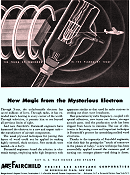 At the same time that
radio frequency waves were being applied to wireless communications, they were
also being used for applications in medicine, food preparation and sterilization,
manufacturing, and in other realms. The usefulness of x-rays was known to most people,
even if they didn't understand them. At much lower frequencies, particularly microwaves,
RF signal interaction with water and other types of liquid molecules provides an
effective and efficient means of heating to accelerate cooking of meat and curing
of adhesives. The latter is what this Fairchild infomercial appearing in a 1944
issue of Popular Science magazine touted as an example of how they are
inventing and applying cutting edge technology to help win World War II. The
use of microwave heating for curing plywood has been used since high power vacuum
tubes capable of those frequencies were invented... At the same time that
radio frequency waves were being applied to wireless communications, they were
also being used for applications in medicine, food preparation and sterilization,
manufacturing, and in other realms. The usefulness of x-rays was known to most people,
even if they didn't understand them. At much lower frequencies, particularly microwaves,
RF signal interaction with water and other types of liquid molecules provides an
effective and efficient means of heating to accelerate cooking of meat and curing
of adhesives. The latter is what this Fairchild infomercial appearing in a 1944
issue of Popular Science magazine touted as an example of how they are
inventing and applying cutting edge technology to help win World War II. The
use of microwave heating for curing plywood has been used since high power vacuum
tubes capable of those frequencies were invented...
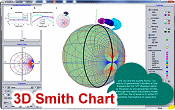 Dr. Andrei
Muller, progenitor of the world's first
3D Smith Chart
software program, has teamed with a handful of able colleagues to release a commercial
version of this paradigm-changing design and analysis tool. 3D Smith Chart
enables you to visualize S-parameter data in ways not possible from the Flatland
dweller's perspective that is the traditional 2D Smith chart. Flatland existed
in a plane, and from an observer's perspective a 3-dimensional object entering the
plane from along the Z-axis seemed to appear out of nowhere; only its distance and
width changed as it passed through. Flatland dwellers rejected the existence or
even the possibility of a third dimension, dismissing offhand a rational requirement
for one, even punishing the citizen who dared to propose such a concept. After all,
two dimensions had served the world just fine. A similar restraint on perspective
is imposed upon the classic 2D Smith chart. 3D Smith Chart does for the
Smith chart what Einstein's concept of Relativity did for physics by adding the
fourth dimension of time. Just as with most new concepts, the true value of the
relatively new 3D Smith Chart (debuted in 2013) has not been grasped yet by
the engineering world. Heck, getting your head around even the classic Smith chart
is daunting enough for the neophyte RF guy (or gal), so a bit of apprehension is
understandable. As with the classic Smith chart... Dr. Andrei
Muller, progenitor of the world's first
3D Smith Chart
software program, has teamed with a handful of able colleagues to release a commercial
version of this paradigm-changing design and analysis tool. 3D Smith Chart
enables you to visualize S-parameter data in ways not possible from the Flatland
dweller's perspective that is the traditional 2D Smith chart. Flatland existed
in a plane, and from an observer's perspective a 3-dimensional object entering the
plane from along the Z-axis seemed to appear out of nowhere; only its distance and
width changed as it passed through. Flatland dwellers rejected the existence or
even the possibility of a third dimension, dismissing offhand a rational requirement
for one, even punishing the citizen who dared to propose such a concept. After all,
two dimensions had served the world just fine. A similar restraint on perspective
is imposed upon the classic 2D Smith chart. 3D Smith Chart does for the
Smith chart what Einstein's concept of Relativity did for physics by adding the
fourth dimension of time. Just as with most new concepts, the true value of the
relatively new 3D Smith Chart (debuted in 2013) has not been grasped yet by
the engineering world. Heck, getting your head around even the classic Smith chart
is daunting enough for the neophyte RF guy (or gal), so a bit of apprehension is
understandable. As with the classic Smith chart...
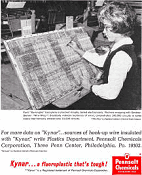 Did you know that at least originally the
term "Wire-Wrap"
was - and maybe still a - registered trademark of Gardner-Denver Company? Kynar
insulation, whose full name is Kynar polyvinylidene fluoride (PVDF) resin, is most
likely a familiar type of insulation due to its widespread use on wire-wrap wire.
It had very recently been introduced to the electronics world when this advertisement
appeared in a 1964 issue of Electronics magazine. The contemporary name used by
its manufacturer, Arkema, is Kynar500®, and the coating's use has expanded well
beyond the electronics industry into architectural and mechanical coatings. I did
a LOT of manual wire-wrapping on Mil-Spec equipment while working as a technician
at Westinghouse Oceanic Division in the early and mid 1980s. The massive wire-wrapped
board shown in the ad was done by an automated machine. There were times that the
guys in my work area (code-named "HK") had to do rework based on an engineering
circuit change. Most often it was a nightmare because the manner in which the machines
wrapped wires on posts (sometimes three-high) required unwrapping and then re-wrapping
dozens of wires because the ones we really needed to access were below a wrap that
was at the top of the post. Workmanship standards prohibited (for good reason) unwrapping
and then re-wrapping the same wire because the sharp edges of the square posts (which
created the gas-tight connections) weakened the wire during straightening... Did you know that at least originally the
term "Wire-Wrap"
was - and maybe still a - registered trademark of Gardner-Denver Company? Kynar
insulation, whose full name is Kynar polyvinylidene fluoride (PVDF) resin, is most
likely a familiar type of insulation due to its widespread use on wire-wrap wire.
It had very recently been introduced to the electronics world when this advertisement
appeared in a 1964 issue of Electronics magazine. The contemporary name used by
its manufacturer, Arkema, is Kynar500®, and the coating's use has expanded well
beyond the electronics industry into architectural and mechanical coatings. I did
a LOT of manual wire-wrapping on Mil-Spec equipment while working as a technician
at Westinghouse Oceanic Division in the early and mid 1980s. The massive wire-wrapped
board shown in the ad was done by an automated machine. There were times that the
guys in my work area (code-named "HK") had to do rework based on an engineering
circuit change. Most often it was a nightmare because the manner in which the machines
wrapped wires on posts (sometimes three-high) required unwrapping and then re-wrapping
dozens of wires because the ones we really needed to access were below a wrap that
was at the top of the post. Workmanship standards prohibited (for good reason) unwrapping
and then re-wrapping the same wire because the sharp edges of the square posts (which
created the gas-tight connections) weakened the wire during straightening...
 Withwave is a leading designer and developer
of a broad range of RF, microwave, and millimeter-wave test solutions and subsystems
with a focus on electromagnetic field analysis and signal processing. Our newly
released
Vertical Launch 0.8 mm Connectors are specially designed for solderless
vertical PCB launch on test & measurement board. These connectors have excellent
electrical transition performance from DC to 145 GHz respectively as well as
reduce installation time by eliminating soldering. Withwave also has a line of 0.8 mm
Connector Adaptors and 0.8 mm Cable Assemblies, all for DC to 145 GHz... Withwave is a leading designer and developer
of a broad range of RF, microwave, and millimeter-wave test solutions and subsystems
with a focus on electromagnetic field analysis and signal processing. Our newly
released
Vertical Launch 0.8 mm Connectors are specially designed for solderless
vertical PCB launch on test & measurement board. These connectors have excellent
electrical transition performance from DC to 145 GHz respectively as well as
reduce installation time by eliminating soldering. Withwave also has a line of 0.8 mm
Connector Adaptors and 0.8 mm Cable Assemblies, all for DC to 145 GHz...
 If you have read as many vintage electronics
magazines as I have, one thing that is obvious is how many of the same issues that
plagued the field since the middle of the last century are still with us today -
only in a much worse way by now.
Government meddling, regulation and taxation are amongst the top offenders.
Both the electric power industry and the communications industry have been hit hard,
and huge costs to consumers is the result. Itemized bills from the utility companies
do not give the full picture of what a large percentage of your monthly premiums
go to feed the government beast. You might see some line items for taxes, surcharges,
contributions and user fees, but those being paid for you by the providers (i.e.,
absorbed in the base charge) are hidden. One of the more recent, highly publicized
example was the "Gore Tax" (Universal Services Fund) that added $1 to everyone's
landline bill to provide subsidized Internet (most people had dial-up at the time)
and other services to schools, libraries, and "the underprivileged." Once most people
had dumped landlines, the FCC started adding fees to cellphone bills to pay for
high speed Internet service (E-Rate) to the aforementioned users. As always, those
of us who pay our own way without burdening others are forced to provide freebies
for a largely undeserving (IMO) host of citizens and non-citizens... If you have read as many vintage electronics
magazines as I have, one thing that is obvious is how many of the same issues that
plagued the field since the middle of the last century are still with us today -
only in a much worse way by now.
Government meddling, regulation and taxation are amongst the top offenders.
Both the electric power industry and the communications industry have been hit hard,
and huge costs to consumers is the result. Itemized bills from the utility companies
do not give the full picture of what a large percentage of your monthly premiums
go to feed the government beast. You might see some line items for taxes, surcharges,
contributions and user fees, but those being paid for you by the providers (i.e.,
absorbed in the base charge) are hidden. One of the more recent, highly publicized
example was the "Gore Tax" (Universal Services Fund) that added $1 to everyone's
landline bill to provide subsidized Internet (most people had dial-up at the time)
and other services to schools, libraries, and "the underprivileged." Once most people
had dumped landlines, the FCC started adding fees to cellphone bills to pay for
high speed Internet service (E-Rate) to the aforementioned users. As always, those
of us who pay our own way without burdening others are forced to provide freebies
for a largely undeserving (IMO) host of citizens and non-citizens...
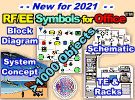 It was a lot of work, but I finally finished
a version of the "RF &
Electronics Schematic & Block Diagram Symbols"" that works well with Microsoft
Office™ programs Word™, Excel™, and Power Point™. This is an equivalent of the extensive
set of amplifier, mixer, filter, switch, connector, waveguide, digital, analog,
antenna, and other commonly used symbols for system block diagrams and schematics
created for Visio™. Each of the 1,000+ symbols was exported individually from Visio
in the EMF file format, then imported into Word on a Drawing Canvas. The EMF format
allows an image to be scaled up or down without becoming pixelated, so all the shapes
can be resized in a document and still look good. The imported symbols can also
be UnGrouped into their original constituent parts for editing... It was a lot of work, but I finally finished
a version of the "RF &
Electronics Schematic & Block Diagram Symbols"" that works well with Microsoft
Office™ programs Word™, Excel™, and Power Point™. This is an equivalent of the extensive
set of amplifier, mixer, filter, switch, connector, waveguide, digital, analog,
antenna, and other commonly used symbols for system block diagrams and schematics
created for Visio™. Each of the 1,000+ symbols was exported individually from Visio
in the EMF file format, then imported into Word on a Drawing Canvas. The EMF format
allows an image to be scaled up or down without becoming pixelated, so all the shapes
can be resized in a document and still look good. The imported symbols can also
be UnGrouped into their original constituent parts for editing...
Thursday the 4th
 For about a year before the end of World
War II, with the surrender of Germany in May 1945 and Japan in September 1945,
companies that had either voluntarily or forcibly converted their efforts and facilities
to the design and production of weapons and support equipment, were running advertisements
in magazines promising grand new products and services for the civil sector based
on knowledge gained from "mother," that is the entity metaphorically credited for
spurning invention. In many ways the promise was kept through advances in radio,
medicine, automation, materials science, recovering and refining of raw materials,
mass production, physics and chemistry, firearms, mathematics, land, water, and
air-based transportation, etc. Lots of war surplus hardware was made available at
huge discounts as a means of thanking the public for sacrifices made during the
war. This "Radio
Builds Railroads in the Sky" article from a 1948 issue of Popular Science
magazine reports on a system of aerial navigation using a triangulation system,
which derives from wartime methods... For about a year before the end of World
War II, with the surrender of Germany in May 1945 and Japan in September 1945,
companies that had either voluntarily or forcibly converted their efforts and facilities
to the design and production of weapons and support equipment, were running advertisements
in magazines promising grand new products and services for the civil sector based
on knowledge gained from "mother," that is the entity metaphorically credited for
spurning invention. In many ways the promise was kept through advances in radio,
medicine, automation, materials science, recovering and refining of raw materials,
mass production, physics and chemistry, firearms, mathematics, land, water, and
air-based transportation, etc. Lots of war surplus hardware was made available at
huge discounts as a means of thanking the public for sacrifices made during the
war. This "Radio
Builds Railroads in the Sky" article from a 1948 issue of Popular Science
magazine reports on a system of aerial navigation using a triangulation system,
which derives from wartime methods...
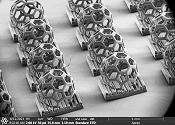 "A new process for microscale 3D printing
creates particles of nearly any shape for applications in medicine, manufacturing,
research, and more - at the pace of up to 1 million particles a day.
3D-printed microscopic particles, so small that to the naked eye they look like
dust, have applications in drug and vaccine delivery, microelectronics, microfluidics,
and abrasives for intricate manufacturing. However, the need for precise coordination
between light delivery, stage movement, and resin properties makes scalable fabrication
of such custom microscale particles challenging. Now, researchers at Stanford University
have introduced a more efficient processing technique that can print up to 1 million
highly detailed and customizable microscale particles a day. 'We can now create
much more complex shapes down to the microscopic scale, at speeds that have not
been shown for particle fabrication previously, and out of a wide range of materials,'
said Jason Kronenfeld, PhD candidate..." "A new process for microscale 3D printing
creates particles of nearly any shape for applications in medicine, manufacturing,
research, and more - at the pace of up to 1 million particles a day.
3D-printed microscopic particles, so small that to the naked eye they look like
dust, have applications in drug and vaccine delivery, microelectronics, microfluidics,
and abrasives for intricate manufacturing. However, the need for precise coordination
between light delivery, stage movement, and resin properties makes scalable fabrication
of such custom microscale particles challenging. Now, researchers at Stanford University
have introduced a more efficient processing technique that can print up to 1 million
highly detailed and customizable microscale particles a day. 'We can now create
much more complex shapes down to the microscopic scale, at speeds that have not
been shown for particle fabrication previously, and out of a wide range of materials,'
said Jason Kronenfeld, PhD candidate..."
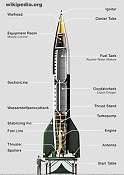 This article by science fiction writer Arthur
C. Clarke, of 2001: A Space Odyssey fame, suggested the use of surplus German V-2
(Vergeltungswaffe
2; i.e., Retribution Weapon 2) rockets for launching scientific payloads into
space rather than for launching terrorizing attacks on European cities. The October
1945 publishing date was after Germany had surrendered in the spring of that year
and Allied forces were rounding up war criminals and confiscating documents and
equipment. Clarke describes how an "artificial satellite" could be caused to circle
the earth "perpetually" and was published in the October 1945 edition of Wireless
World magazine. The pilot-less V-2, along with the V-1 "Buzz Bomb," were launched
from within Germany and caused massive structural damage and human death and suffering.
For war progenitor and aggressor, Germany, to call it a retribution weapon was a
gross misnomer, especially considering it was the second time (WWI and WWII) in
three decades that the country had attempted to bring Europe under its dominance
with brutal assaults... This article by science fiction writer Arthur
C. Clarke, of 2001: A Space Odyssey fame, suggested the use of surplus German V-2
(Vergeltungswaffe
2; i.e., Retribution Weapon 2) rockets for launching scientific payloads into
space rather than for launching terrorizing attacks on European cities. The October
1945 publishing date was after Germany had surrendered in the spring of that year
and Allied forces were rounding up war criminals and confiscating documents and
equipment. Clarke describes how an "artificial satellite" could be caused to circle
the earth "perpetually" and was published in the October 1945 edition of Wireless
World magazine. The pilot-less V-2, along with the V-1 "Buzz Bomb," were launched
from within Germany and caused massive structural damage and human death and suffering.
For war progenitor and aggressor, Germany, to call it a retribution weapon was a
gross misnomer, especially considering it was the second time (WWI and WWII) in
three decades that the country had attempted to bring Europe under its dominance
with brutal assaults...
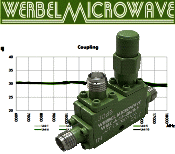 Model WMC-6-18-30dB-S from Werbel Microwave
is a
directional coupler that covers 6 to 18 GHz with broadband flat coupling
response, high directivity, and excellent return loss performance. The high coupling
value and short mainline minimizes lost power during the monitoring. Covers the
upper half of C band, X band and Ku band in a single package measuring only 1.00
x 0.6 x 0.5 inches. Our unique design approach to couplers provides a maximally
flat coupling response across the passband with minimal ripple, typically ±0.5 dB
or less. Directivity 14 dB typical. Return loss 21 dB typical. Insertion
loss 0.4 dB typical. Assembled and tested in USA using RoHS compliant materials,
although lead solder may be used on special order to support military applications... Model WMC-6-18-30dB-S from Werbel Microwave
is a
directional coupler that covers 6 to 18 GHz with broadband flat coupling
response, high directivity, and excellent return loss performance. The high coupling
value and short mainline minimizes lost power during the monitoring. Covers the
upper half of C band, X band and Ku band in a single package measuring only 1.00
x 0.6 x 0.5 inches. Our unique design approach to couplers provides a maximally
flat coupling response across the passband with minimal ripple, typically ±0.5 dB
or less. Directivity 14 dB typical. Return loss 21 dB typical. Insertion
loss 0.4 dB typical. Assembled and tested in USA using RoHS compliant materials,
although lead solder may be used on special order to support military applications...
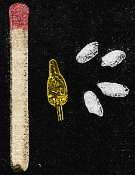 A month before Bell Laboratories' announcement
of the transistor invention by Mssrs. Bardeen, Shockley and Brattain, Radio-Craft
magazine editor Hugo Gernsback published a piece extolling the virtues of a newly
developed
microtube, aka a "rice-grain" tube. As connected as Gernsback was in the electronics
industry, it is doubtful he knew of the impending game-changing invention. Commercialization
of the transistor took a few years to get to the point where the devices could be
manufactured cheaply and reliably enough to begin being integrated (pun intended)
into products, so vacuum tubes still reigned for another decade or more. While the
microtubes were designed into such products as portable radios, hearing aids, and
other things in desperate need of size reduction, standard tubes continued to be
used in the majority of things. Even the military and aerospace industries elected
largely to pass on microtubes and instead wait for semiconductors. Still, there
was no guarantee in 1947 that solid state would ever displace vacuum tubes for anything
other than specialty products; it was still a very much unknown realm. Gernsback
quickly embraced transistors after the announcement was made... A month before Bell Laboratories' announcement
of the transistor invention by Mssrs. Bardeen, Shockley and Brattain, Radio-Craft
magazine editor Hugo Gernsback published a piece extolling the virtues of a newly
developed
microtube, aka a "rice-grain" tube. As connected as Gernsback was in the electronics
industry, it is doubtful he knew of the impending game-changing invention. Commercialization
of the transistor took a few years to get to the point where the devices could be
manufactured cheaply and reliably enough to begin being integrated (pun intended)
into products, so vacuum tubes still reigned for another decade or more. While the
microtubes were designed into such products as portable radios, hearing aids, and
other things in desperate need of size reduction, standard tubes continued to be
used in the majority of things. Even the military and aerospace industries elected
largely to pass on microtubes and instead wait for semiconductors. Still, there
was no guarantee in 1947 that solid state would ever displace vacuum tubes for anything
other than specialty products; it was still a very much unknown realm. Gernsback
quickly embraced transistors after the announcement was made...
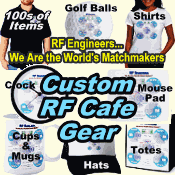 This assortment of custom-designed themes
by RF Cafe includes T-Shirts, Mouse Pads, Clocks, Tote Bags, Coffee Mugs and Steins,
Purses, Sweatshirts, Baseball Caps, and more, all sporting my amazingly clever "RF Engineers - We Are the World's
Matchmakers" Smith chart design. These would make excellent gifts for husbands,
wives, kids, significant others, and for handing out at company events or as rewards
for excellent service. My graphic has been ripped off by other people and used on
their products, so please be sure to purchase only official RF Cafe gear. I only
make a couple bucks on each sale - the rest goes to Cafe Press. It's a great way
to help support RF Cafe. Thanks... This assortment of custom-designed themes
by RF Cafe includes T-Shirts, Mouse Pads, Clocks, Tote Bags, Coffee Mugs and Steins,
Purses, Sweatshirts, Baseball Caps, and more, all sporting my amazingly clever "RF Engineers - We Are the World's
Matchmakers" Smith chart design. These would make excellent gifts for husbands,
wives, kids, significant others, and for handing out at company events or as rewards
for excellent service. My graphic has been ripped off by other people and used on
their products, so please be sure to purchase only official RF Cafe gear. I only
make a couple bucks on each sale - the rest goes to Cafe Press. It's a great way
to help support RF Cafe. Thanks...
Wednesday the 3rd
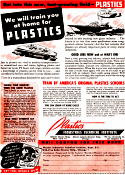 Various forms of plastics began appearing
in laboratories in the early 1800s. Polystyrene was invented by Eduard Simon around
1839, polyvinyl chloride (PVC) was created by Eugen Baumann in 1872, Jacques Brandenberger
came up with cellophane in 1908, acrylic appeared in 1936, and polyurethane in 1937.
Whinfield and Dickson invented polyethylene terephthalate (Pet) in 1941, 1951 saw
polypropylene (PP) invented by Paul Hogan and Robert Banks, and Dow Chemical came
out with Styrofoam in 1954, and polyimides appeared in 1964. When this full-page
advertisement by the
Plastics Industries Technical Institute appeared in Popular Science
magazine in 1944, plastic had gained a lot of favor in the public realm thanks to
its application in fighting against Axis powers in World War II. Rugged, lightweight,
highly formable canopies and windshields for aircraft, trucks, and boats were significant
advantages over glass. Use for lightweight and durable field equipment and clothing,
as well as components in artillery equipment was also extremely helpful in our ultimate
victory. "There is a tremendous demand for men and women trained in this exciting
new giant industry. The future is so vast that some predictions seem exaggerated
- almost fantastic..." Various forms of plastics began appearing
in laboratories in the early 1800s. Polystyrene was invented by Eduard Simon around
1839, polyvinyl chloride (PVC) was created by Eugen Baumann in 1872, Jacques Brandenberger
came up with cellophane in 1908, acrylic appeared in 1936, and polyurethane in 1937.
Whinfield and Dickson invented polyethylene terephthalate (Pet) in 1941, 1951 saw
polypropylene (PP) invented by Paul Hogan and Robert Banks, and Dow Chemical came
out with Styrofoam in 1954, and polyimides appeared in 1964. When this full-page
advertisement by the
Plastics Industries Technical Institute appeared in Popular Science
magazine in 1944, plastic had gained a lot of favor in the public realm thanks to
its application in fighting against Axis powers in World War II. Rugged, lightweight,
highly formable canopies and windshields for aircraft, trucks, and boats were significant
advantages over glass. Use for lightweight and durable field equipment and clothing,
as well as components in artillery equipment was also extremely helpful in our ultimate
victory. "There is a tremendous demand for men and women trained in this exciting
new giant industry. The future is so vast that some predictions seem exaggerated
- almost fantastic..."
 Not being satisfied with merely providing
the solution for the resistor cube, Mr. John Carpenter followed up with an
application of the "Equivalent
Resistors of Polyhedral Resistive Structures" method. He states: The paper by
F. J. van Steenwijk is beautiful. Having a current of I / (H - 1) leaving the remaining
terminals is a wonderful insight. Before you post anything, I should tell the other
part of the story. This puzzle has been around for over a century. For instance
it appeared in Brooks, E.E. and A. W. Poyser, Electricity and Magnetism: A Manual
for Advanced Classes, Longmans, Green, 1914. I found this reference [for a Resistor
Tesseract]. It was also in the 1912 edition of the same book. I hav[n't] seen any
earlier references to it. And yet there seem to be very few efforts to draw the
circuit as a planar network which shows the three planar axes of symmetry through
the cube. I set out to do this, and considered what the cube would look like if
it were drawn on a great circle map with the input node at the centre and the output
on the other side of the sphere. That got me to Fig. 2 on the cube page in the attached
file. I then straightened some of the lines which got me to Fig 3. The three planes
of symmetry in the cube are now very apparent, which makes the points of equal voltage
apparent. This makes the parallel resistor solution very straightforward. Fig. 3
also makes it very straightforward to seen the current distribution, and derive
a solution by summing voltages. I suggest to you that Fig. 3 makes the problem very
much easier, if not trivial... Not being satisfied with merely providing
the solution for the resistor cube, Mr. John Carpenter followed up with an
application of the "Equivalent
Resistors of Polyhedral Resistive Structures" method. He states: The paper by
F. J. van Steenwijk is beautiful. Having a current of I / (H - 1) leaving the remaining
terminals is a wonderful insight. Before you post anything, I should tell the other
part of the story. This puzzle has been around for over a century. For instance
it appeared in Brooks, E.E. and A. W. Poyser, Electricity and Magnetism: A Manual
for Advanced Classes, Longmans, Green, 1914. I found this reference [for a Resistor
Tesseract]. It was also in the 1912 edition of the same book. I hav[n't] seen any
earlier references to it. And yet there seem to be very few efforts to draw the
circuit as a planar network which shows the three planar axes of symmetry through
the cube. I set out to do this, and considered what the cube would look like if
it were drawn on a great circle map with the input node at the centre and the output
on the other side of the sphere. That got me to Fig. 2 on the cube page in the attached
file. I then straightened some of the lines which got me to Fig 3. The three planes
of symmetry in the cube are now very apparent, which makes the points of equal voltage
apparent. This makes the parallel resistor solution very straightforward. Fig. 3
also makes it very straightforward to seen the current distribution, and derive
a solution by summing voltages. I suggest to you that Fig. 3 makes the problem very
much easier, if not trivial...
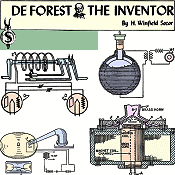 When most people are asked to name
prolific inventors, people like Thomas Edison and George Westinghouse, with
1084 and 361 each, respectively, come to mind - at least for the United States.
As of this writing, Kangguo Cheng of IBM holds the record with 2039 U.S. patents
assigned. Nikola Tesla had about 300 patents. Lee de Forest, the subject of
this 1937 Radio-Craft article, had a little over 180 patents. That still
qualifies as prolific by my estimation. However, there is more to ranking a person's
inventive worth than the number of patents awarded - like how profoundly his or
her invention(s) impacted the world. For instance, Alexander Graham Bell had a mere
18 patents awarded in only his name, with 12 more shared patents. If you look through
Wikipedia's "List of Prolific Inventors," you will see a lot of names with a lot
of patents assigned, but most of those names are probably unfamiliar. Notice how
many of the old patent art looks like something from a Dr. Seuss kids' book;
e.g., Figure 5, "A pneumatic telephone for communication on trains." See the
January 1947 Radio-Craft table of contents for more articles on Lee de Forest... When most people are asked to name
prolific inventors, people like Thomas Edison and George Westinghouse, with
1084 and 361 each, respectively, come to mind - at least for the United States.
As of this writing, Kangguo Cheng of IBM holds the record with 2039 U.S. patents
assigned. Nikola Tesla had about 300 patents. Lee de Forest, the subject of
this 1937 Radio-Craft article, had a little over 180 patents. That still
qualifies as prolific by my estimation. However, there is more to ranking a person's
inventive worth than the number of patents awarded - like how profoundly his or
her invention(s) impacted the world. For instance, Alexander Graham Bell had a mere
18 patents awarded in only his name, with 12 more shared patents. If you look through
Wikipedia's "List of Prolific Inventors," you will see a lot of names with a lot
of patents assigned, but most of those names are probably unfamiliar. Notice how
many of the old patent art looks like something from a Dr. Seuss kids' book;
e.g., Figure 5, "A pneumatic telephone for communication on trains." See the
January 1947 Radio-Craft table of contents for more articles on Lee de Forest...
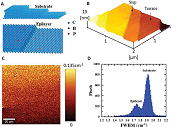 "A
National Institute for Materials Science (NIMS) research team has developed the
world's first
n-channel diamond MOSFET (metal-oxide-semiconductor field-effect transistor).
The developed n-channel diamond MOSFET provides a key step toward CMOS integrated
circuits for harsh environment applications, as well as the development of diamond
power electronics. The research is published in Advanced Science. Semiconductor
diamond has outstanding physical properties such as ultra wide-bandgap energy of
5.5 eV, high carriers mobilities, and high thermal conductivity, which is promising
for the applications under extreme environmental conditions with high performance
and high reliability, such as the environments with high temperatures and high levels
of radiation (e.g., in proximity to nuclear reactor cores). By using diamond electronics,
not only can the thermal management demand for conventional semiconductors be alleviated
but these devices are also more energy efficient and can endure much higher breakdown
voltages and harsh environments..." "A
National Institute for Materials Science (NIMS) research team has developed the
world's first
n-channel diamond MOSFET (metal-oxide-semiconductor field-effect transistor).
The developed n-channel diamond MOSFET provides a key step toward CMOS integrated
circuits for harsh environment applications, as well as the development of diamond
power electronics. The research is published in Advanced Science. Semiconductor
diamond has outstanding physical properties such as ultra wide-bandgap energy of
5.5 eV, high carriers mobilities, and high thermal conductivity, which is promising
for the applications under extreme environmental conditions with high performance
and high reliability, such as the environments with high temperatures and high levels
of radiation (e.g., in proximity to nuclear reactor cores). By using diamond electronics,
not only can the thermal management demand for conventional semiconductors be alleviated
but these devices are also more energy efficient and can endure much higher breakdown
voltages and harsh environments..."
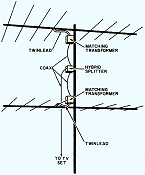 You probably won't find too many people
stacking television antennas these days, but many Hams still do it. Vertical
stacking is used primarily to increase overall gain without appreciably altering
the azimuth beam, while horizontal stacking forms a tighter azimuth beam without
appreciably affecting the overall gain. When it comes to optimizing antenna designs
installations for operations below about a gigahertz, Amateur Radio practitioners
have pretty much written the book on the subject - actually, they have written hundreds
of books on the subject. Antenna stacking is often used in areas where space and/or
neighborhood covenants restrict the size and placement of external structures, but
as pointed out in this article, it also may be the only solution for getting consistent
performance in the presence of widely varying signal path conditions. Note that
the TV channel / frequency table does not include the UHF band. That is likely because
UHF at the time (1965) was not where the major broadcast stations transmitted, so
not as many people would have been concerned with them. It wasn't until the mid
to late 1950's in the U.S. that UHF started becoming widely used... You probably won't find too many people
stacking television antennas these days, but many Hams still do it. Vertical
stacking is used primarily to increase overall gain without appreciably altering
the azimuth beam, while horizontal stacking forms a tighter azimuth beam without
appreciably affecting the overall gain. When it comes to optimizing antenna designs
installations for operations below about a gigahertz, Amateur Radio practitioners
have pretty much written the book on the subject - actually, they have written hundreds
of books on the subject. Antenna stacking is often used in areas where space and/or
neighborhood covenants restrict the size and placement of external structures, but
as pointed out in this article, it also may be the only solution for getting consistent
performance in the presence of widely varying signal path conditions. Note that
the TV channel / frequency table does not include the UHF band. That is likely because
UHF at the time (1965) was not where the major broadcast stations transmitted, so
not as many people would have been concerned with them. It wasn't until the mid
to late 1950's in the U.S. that UHF started becoming widely used...
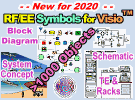 With more than 1000
custom-built symbols, this has got to be the most comprehensive set of
Visio Symbols
available for RF, analog, and digital system and schematic drawings! Every object
has been built to fit proportionally on the provided A-, B- and C-size drawing page
templates (or can use your own). Symbols are provided for equipment racks and test
equipment, system block diagrams, conceptual drawings, and schematics. Unlike previous
versions, these are NOT Stencils, but instead are all contained on tabbed pages
within a single Visio document. That puts everything in front of you in its full
glory. Just copy and paste what you need on your drawing... With more than 1000
custom-built symbols, this has got to be the most comprehensive set of
Visio Symbols
available for RF, analog, and digital system and schematic drawings! Every object
has been built to fit proportionally on the provided A-, B- and C-size drawing page
templates (or can use your own). Symbols are provided for equipment racks and test
equipment, system block diagrams, conceptual drawings, and schematics. Unlike previous
versions, these are NOT Stencils, but instead are all contained on tabbed pages
within a single Visio document. That puts everything in front of you in its full
glory. Just copy and paste what you need on your drawing...
Tuesday the 2nd
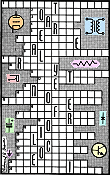 Here is another "R-E
Puzzler," by Mr. Edmund Braun, this one in the April 1967 issue of
Radio-Electronics magazine. Unlike traditional crossword puzzles, this one
has no linking Down words, only Across words. Maybe he should have dubbed it an
"acrossword puzzle." The format does make figuring out some of the words more difficult
than the other way, but at least one letter - never more than two - is provided
for each word. I managed to get all except number 7, "Phenolic compound having good
electrical resistance." After looking at the answer, I feel like an idiot - definitely
should have gotten it after mentioning it in my write-ups so often. Hopefully, you
will do better. If you like this R-E Puzzler, there are others... Here is another "R-E
Puzzler," by Mr. Edmund Braun, this one in the April 1967 issue of
Radio-Electronics magazine. Unlike traditional crossword puzzles, this one
has no linking Down words, only Across words. Maybe he should have dubbed it an
"acrossword puzzle." The format does make figuring out some of the words more difficult
than the other way, but at least one letter - never more than two - is provided
for each word. I managed to get all except number 7, "Phenolic compound having good
electrical resistance." After looking at the answer, I feel like an idiot - definitely
should have gotten it after mentioning it in my write-ups so often. Hopefully, you
will do better. If you like this R-E Puzzler, there are others...
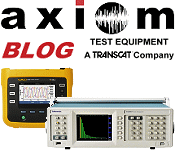 Axiom Test Equipment, an electronic test
equipment rental and sales company has published a new blog post that covers
Power Analyzers vs. Power Quality Analyzers, and how to select the correct one
for your application. Power and its quality from various supplies, such as charging
stations, must be established, and maintained through appropriate measurement cycles,
and power analyzers and power quality analyzers are among the best equipment for
regularly checking on power supplies and how well they are performing. The basic
difference between the types of units is that power analyzers measure power while
power quality analyzers measure the quality of power over time. Finding an AC/DC
electric power measurement solution can take time, due to the large assortment of
performance parameters associated with power and power quality. Fortunately, by
understanding the needs of an application for electric power, selection of the optimum
measurement tools for power analysis can be simplified and how well a power supply
meets the requirements of a particular electric load can be determined. Power analysis
involves measurements of key electrical parameters... Axiom Test Equipment, an electronic test
equipment rental and sales company has published a new blog post that covers
Power Analyzers vs. Power Quality Analyzers, and how to select the correct one
for your application. Power and its quality from various supplies, such as charging
stations, must be established, and maintained through appropriate measurement cycles,
and power analyzers and power quality analyzers are among the best equipment for
regularly checking on power supplies and how well they are performing. The basic
difference between the types of units is that power analyzers measure power while
power quality analyzers measure the quality of power over time. Finding an AC/DC
electric power measurement solution can take time, due to the large assortment of
performance parameters associated with power and power quality. Fortunately, by
understanding the needs of an application for electric power, selection of the optimum
measurement tools for power analysis can be simplified and how well a power supply
meets the requirements of a particular electric load can be determined. Power analysis
involves measurements of key electrical parameters...
 Thomas Edison would be proud at the inventiveness
of entrepreneur Larry Birnbaum. So am I. By now we all know about the ludicrous
worldwide ban on the sale of incandescent light bulbs over a certain wattage. Here
in the U.S., the ban was slated to begin in January of 2012 with prohibition against
100 watt bulbs, and over a couple years would eventually ban the sale of anything
larger than 40 watts. Instead, we are to buy mercury-filled, electronic waste-filled
CFL bulbs or >$60 apiece LED bulbs. Within that 40-to-100 W range, several
classes of specialty lights are exempt from the regulation including appliance lamps,
rough service bulbs, 3-way bulbs, colored lamps, stage lighting, and plant lights.
The rough-service class is where Mr. Birnbaum and his
Newcandescent™ company (now
defunct) comes in. Unlike the standard incandescent bulb that is typically rated
for a 750-to-1,000-hour lifetime, Newcandescent bulbs are rated for a 10,000 hour
lifetime (10x-to-13x as long). They are advertised at 7 years. Anyone who has used
CFL bulbs has probably already experienced a failure - long before their expected
longevity of 5-7 years. Standard frosted incandescent bulbs from Newcandescent cost
$2.88 each... Thomas Edison would be proud at the inventiveness
of entrepreneur Larry Birnbaum. So am I. By now we all know about the ludicrous
worldwide ban on the sale of incandescent light bulbs over a certain wattage. Here
in the U.S., the ban was slated to begin in January of 2012 with prohibition against
100 watt bulbs, and over a couple years would eventually ban the sale of anything
larger than 40 watts. Instead, we are to buy mercury-filled, electronic waste-filled
CFL bulbs or >$60 apiece LED bulbs. Within that 40-to-100 W range, several
classes of specialty lights are exempt from the regulation including appliance lamps,
rough service bulbs, 3-way bulbs, colored lamps, stage lighting, and plant lights.
The rough-service class is where Mr. Birnbaum and his
Newcandescent™ company (now
defunct) comes in. Unlike the standard incandescent bulb that is typically rated
for a 750-to-1,000-hour lifetime, Newcandescent bulbs are rated for a 10,000 hour
lifetime (10x-to-13x as long). They are advertised at 7 years. Anyone who has used
CFL bulbs has probably already experienced a failure - long before their expected
longevity of 5-7 years. Standard frosted incandescent bulbs from Newcandescent cost
$2.88 each...
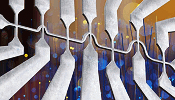 "A research team from the Helmholtz-Zentrum
Dresden-Rossendorf (HZDR) and the University of Salerno in Italy has discovered
that thin films of elemental bismuth exhibit the so-called
non-linear Hall effect, which could be applied in technologies for the controlled
use of terahertz high-frequency signals on electronic chips. Bismuth combines several
advantageous properties not found in other systems to date, as the team reports
in Nature Electronics. Particularly: the quantum effect is observed at room temperature.
The thin-layer films can be applied even on plastic substrates and could therefore
be suitable for modern high-frequency technology applications. 'When we apply a
current to certain materials, they can generate a voltage perpendicular to it. We
physicists call this phenomenon the Hall effect, which is actually a unifying term
for effects with the same impact, but which differ in the underlying mechanisms
at the electron level. Typically, the Hall voltage registered is linearly dependent
on the applied current,' says Dr. Denys Makarov..." "A research team from the Helmholtz-Zentrum
Dresden-Rossendorf (HZDR) and the University of Salerno in Italy has discovered
that thin films of elemental bismuth exhibit the so-called
non-linear Hall effect, which could be applied in technologies for the controlled
use of terahertz high-frequency signals on electronic chips. Bismuth combines several
advantageous properties not found in other systems to date, as the team reports
in Nature Electronics. Particularly: the quantum effect is observed at room temperature.
The thin-layer films can be applied even on plastic substrates and could therefore
be suitable for modern high-frequency technology applications. 'When we apply a
current to certain materials, they can generate a voltage perpendicular to it. We
physicists call this phenomenon the Hall effect, which is actually a unifying term
for effects with the same impact, but which differ in the underlying mechanisms
at the electron level. Typically, the Hall voltage registered is linearly dependent
on the applied current,' says Dr. Denys Makarov..."
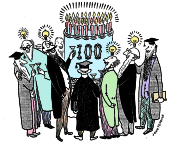 Here is a good quiz that tests your knowledge
of classifications of science fields. It appeared in a 1949 edition of The Saturday
Evening Post magazine. Even if you do not particularly know the relationships,
you should be able to get most if not all twelve correct with a combination of surety,
recognition of word roots, and a process of elimination. I managed to guess 10 out
of the 12. Good luck. BTW, I bestowed the clown colors on the distinguished professors'
duds... Here is a good quiz that tests your knowledge
of classifications of science fields. It appeared in a 1949 edition of The Saturday
Evening Post magazine. Even if you do not particularly know the relationships,
you should be able to get most if not all twelve correct with a combination of surety,
recognition of word roots, and a process of elimination. I managed to guess 10 out
of the 12. Good luck. BTW, I bestowed the clown colors on the distinguished professors'
duds...
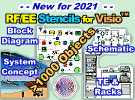 With more than 1000
custom-built stencils, this has got to be the most comprehensive set of
Visio Stencils
available for RF, analog, and digital system and schematic drawings! Every stencil
symbol has been built to fit proportionally on the included A-, B-, and C-size drawing
page templates (or use your own page if preferred). Components are provided for
system block diagrams, conceptual drawings, schematics, test equipment, racks, and
more. Page templates are provided with a preset scale (changeable) for a good presentation
that can incorporate all provided symbols... With more than 1000
custom-built stencils, this has got to be the most comprehensive set of
Visio Stencils
available for RF, analog, and digital system and schematic drawings! Every stencil
symbol has been built to fit proportionally on the included A-, B-, and C-size drawing
page templates (or use your own page if preferred). Components are provided for
system block diagrams, conceptual drawings, schematics, test equipment, racks, and
more. Page templates are provided with a preset scale (changeable) for a good presentation
that can incorporate all provided symbols...
Monday the 1st
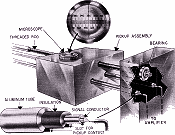 I don't know where the name Mohammed Ulysses
Fips came from, but it is the pseudonym chosen by editor Hugo Gernsback. The first
and middle names are easy enough to ascertain an origin. According to the iGENEA
website: "The last name Fips is most commonly found in the Netherlands, as well
as in other parts of Europe. The surname originated in the Netherlands, likely from
personal names or nicknames related to the word 'vips' ('expensive' or 'luxurious').
The earliest recorded Fips dates back to 1490 in the Netherlands." Hugo Gernsback
was born in 1884 in Luxembourg City (Luxembourg), separated only by Belguim from
the Netherlands, so maybe that is where he came up with it. For some reason, the
articles written by Mohammed Ulysses Fips, purportedly a member of the Islamic Radio
Engineers (I.R.E), always appeared in April issues of Radio-Craft and
Radio-Electronics magazine. Here is his "30-Day LP Record" entry... I don't know where the name Mohammed Ulysses
Fips came from, but it is the pseudonym chosen by editor Hugo Gernsback. The first
and middle names are easy enough to ascertain an origin. According to the iGENEA
website: "The last name Fips is most commonly found in the Netherlands, as well
as in other parts of Europe. The surname originated in the Netherlands, likely from
personal names or nicknames related to the word 'vips' ('expensive' or 'luxurious').
The earliest recorded Fips dates back to 1490 in the Netherlands." Hugo Gernsback
was born in 1884 in Luxembourg City (Luxembourg), separated only by Belguim from
the Netherlands, so maybe that is where he came up with it. For some reason, the
articles written by Mohammed Ulysses Fips, purportedly a member of the Islamic Radio
Engineers (I.R.E), always appeared in April issues of Radio-Craft and
Radio-Electronics magazine. Here is his "30-Day LP Record" entry...
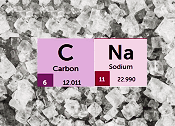 From Bill Schweber at the Microwaves &
RF website: "Two essential elements resent being maligned for the implications
of their higher-level molecules. Representatives of the recently formed
Society for Elemental Justice (SEJ) announced that they're suing major media
and related institutions for misuse of the basic terms 'carbon' and 'sodium' in
place of the full molecule designations 'carbon dioxide' (CO2) and 'sodium chloride'
(NaCl). Speaking on behalf of these vital elements, SEJ says these elements are
constantly being libeled and slandered when they're cited as sources of climate
or health issues. The spokesperson noted that 'carbon' (atomic number 6, symbol
C) is a vital building block for life as well as many industrial processes and products,
whether it's seen as graphite, diamonds, or many other allotropic forms. Further,
carbon is harmless in its elemental state. Sodium (atomic number 11, symbol Na)
is also being maligned... From Bill Schweber at the Microwaves &
RF website: "Two essential elements resent being maligned for the implications
of their higher-level molecules. Representatives of the recently formed
Society for Elemental Justice (SEJ) announced that they're suing major media
and related institutions for misuse of the basic terms 'carbon' and 'sodium' in
place of the full molecule designations 'carbon dioxide' (CO2) and 'sodium chloride'
(NaCl). Speaking on behalf of these vital elements, SEJ says these elements are
constantly being libeled and slandered when they're cited as sources of climate
or health issues. The spokesperson noted that 'carbon' (atomic number 6, symbol
C) is a vital building block for life as well as many industrial processes and products,
whether it's seen as graphite, diamonds, or many other allotropic forms. Further,
carbon is harmless in its elemental state. Sodium (atomic number 11, symbol Na)
is also being maligned...
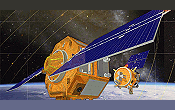 "In April 2007, the Defense Advanced Research
Projects Agency demonstrated the ability to refuel a satellite in orbit - equipping
a spacecraft with a robotic arm, docking it to another spacecraft and transferring
nearly 32 pounds of hydrazine into its fuel tank. The mission, known as Orbital
Express, was full of technology firsts, according to Fred Kennedy, who led the project
for DARPA. Along with demonstrating the first-ever
in-space refueling operation, the U.S. mission showcased the ability to use
tracking and imaging sensors to attach to a receiving satellite and perform maintenance,
such as swapping out a battery or replacing a flight computer. 'The big deal was
autonomy,' Kennedy told C4ISRNET in a Feb. 27 interview. 'We were able to show sort
of a push-button approach to getting up close and personal to a spacecraft and delivering
a variety of servicing capabilities.' But four months after it took flight, the
Air Force and NASA - DARPA's mission partners for the effort - pulled the plug on
the program. The project, conceived to support a space-based radar program that
was canceled before Orbital Express even got off the ground, lacked a clear mission
application, according to the Air Force and NASA. Orbital Express undergoes testing
in space. (U.S. Defense Advanced Research Projects Agency) The outcome wasn't particularly
surprising for DARPA, whose projects often explore technologies that are ahead of
their time..." "In April 2007, the Defense Advanced Research
Projects Agency demonstrated the ability to refuel a satellite in orbit - equipping
a spacecraft with a robotic arm, docking it to another spacecraft and transferring
nearly 32 pounds of hydrazine into its fuel tank. The mission, known as Orbital
Express, was full of technology firsts, according to Fred Kennedy, who led the project
for DARPA. Along with demonstrating the first-ever
in-space refueling operation, the U.S. mission showcased the ability to use
tracking and imaging sensors to attach to a receiving satellite and perform maintenance,
such as swapping out a battery or replacing a flight computer. 'The big deal was
autonomy,' Kennedy told C4ISRNET in a Feb. 27 interview. 'We were able to show sort
of a push-button approach to getting up close and personal to a spacecraft and delivering
a variety of servicing capabilities.' But four months after it took flight, the
Air Force and NASA - DARPA's mission partners for the effort - pulled the plug on
the program. The project, conceived to support a space-based radar program that
was canceled before Orbital Express even got off the ground, lacked a clear mission
application, according to the Air Force and NASA. Orbital Express undergoes testing
in space. (U.S. Defense Advanced Research Projects Agency) The outcome wasn't particularly
surprising for DARPA, whose projects often explore technologies that are ahead of
their time..."
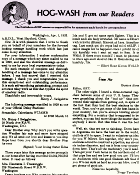 The editors of the American Radio Relay
League's (ARRL's) QST magazine went all out for April Fool's Day in 1933.
Maybe it was a way to help ease the pain of the country's ongoing Great Depression.
Amongst the proof of my statement are items like "The American Radiator Delay League,"
"Quiescent Autonomous Magnification Superintendence," "At Last - Some Different
Toobs!," and "I Will Not Bite His Ear, or the Rover Radio Boys on the Moon."There
are others that I haven't gotten around to publishing yet. Humor was a bit different
nearly a century ago, so expect some head scratching to figure out what the con
is. This "Hog-Wash
from Our Readers" column is a variation of the regular reader-submitted comments.
Pay careful attention to the spellings of words - a common mechanism used back in
the day... The editors of the American Radio Relay
League's (ARRL's) QST magazine went all out for April Fool's Day in 1933.
Maybe it was a way to help ease the pain of the country's ongoing Great Depression.
Amongst the proof of my statement are items like "The American Radiator Delay League,"
"Quiescent Autonomous Magnification Superintendence," "At Last - Some Different
Toobs!," and "I Will Not Bite His Ear, or the Rover Radio Boys on the Moon."There
are others that I haven't gotten around to publishing yet. Humor was a bit different
nearly a century ago, so expect some head scratching to figure out what the con
is. This "Hog-Wash
from Our Readers" column is a variation of the regular reader-submitted comments.
Pay careful attention to the spellings of words - a common mechanism used back in
the day...
 Anatech Electronics offers the industry's
largest portfolio of high-performance standard and customized
RF and microwave filters and filter-related products for military, commercial,
aerospace and defense, and industrial applications up to 40 GHz. Three new
filters have been announced for April 2024 - a 2000 MHz cavity bandpass filter with
a 1 dB bandwidth, a 5250 MHz cavity bandpass filter with a 33 MHz 3 dB
bandwidth, and a 5000 MHz cavity bandpass filter with a 200 MHz bandwidth.
Custom RF power filter and directional couplers designs can be designed and produced
with required connector types when a standard cannot be found, or the requirements
are such that a custom approach is necessary... Anatech Electronics offers the industry's
largest portfolio of high-performance standard and customized
RF and microwave filters and filter-related products for military, commercial,
aerospace and defense, and industrial applications up to 40 GHz. Three new
filters have been announced for April 2024 - a 2000 MHz cavity bandpass filter with
a 1 dB bandwidth, a 5250 MHz cavity bandpass filter with a 33 MHz 3 dB
bandwidth, and a 5000 MHz cavity bandpass filter with a 200 MHz bandwidth.
Custom RF power filter and directional couplers designs can be designed and produced
with required connector types when a standard cannot be found, or the requirements
are such that a custom approach is necessary...
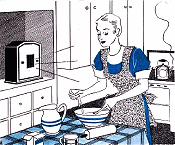 This 1934 edition of Tower Radio
magazine was thrown in with a batch of vintage radio magazines I bought on eBay.
Most of the content pertains to entertainers of the day rather than with technical
issues. Reportedly, it was only sold at Woolworth's stores. Ironically, the number
of households with
over-the-air (OTA) radio listeners today, at least as a percentage of the population
if not in absolute numbers, is probably about the same as in 1934 when commercial
radio broadcasting was just getting a foothold. These days, many - if not most -
people listen to radio and podcasts via cellphone and/or Internet streaming media
than from over-the-air broadcasts, even while in their cars. Organizations like
the National Association of Broadcasters (NAB) are trying to change that, but it's
an uphill battle. I tune in to OTA when possible, but with my radio sitting close
to the computer with all the EMI it spews, it is nearly to impossible to get a clean
AM signal... This 1934 edition of Tower Radio
magazine was thrown in with a batch of vintage radio magazines I bought on eBay.
Most of the content pertains to entertainers of the day rather than with technical
issues. Reportedly, it was only sold at Woolworth's stores. Ironically, the number
of households with
over-the-air (OTA) radio listeners today, at least as a percentage of the population
if not in absolute numbers, is probably about the same as in 1934 when commercial
radio broadcasting was just getting a foothold. These days, many - if not most -
people listen to radio and podcasts via cellphone and/or Internet streaming media
than from over-the-air broadcasts, even while in their cars. Organizations like
the National Association of Broadcasters (NAB) are trying to change that, but it's
an uphill battle. I tune in to OTA when possible, but with my radio sitting close
to the computer with all the EMI it spews, it is nearly to impossible to get a clean
AM signal...
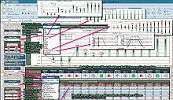
Whilst working on a new version of RF Cascade Workbook (which is a ways off),
I found two rows of redundant calculations in the Filter & LO area. If you own
any previous version of RFCW2018, I will be glad to send you a the new file if you
send me an e-mail.
RF Cascade Workbook is the next phase in the evolution of RF Cafe's long-running
series, RF Cascade Workbook. Chances are you have never used a spreadsheet
quite like this (click
here for screen capture). It is a full-featured RF system cascade parameter
and frequency planner that includes filters and mixers for a mere $45. Built in
MS Excel, using RF Cascade Workbook is a cinch and the format
is entirely customizable. It is significantly easier and faster than using a multi-thousand
dollar simulator when a high level system analysis is all that is needed...
These archive pages are provided in order to make it easier for you to find items
that you remember seeing on the RF Cafe homepage. Of course probably the easiest
way to find anything on the website is to use the "Search
RF Cafe" box at the top of every page.
About RF Cafe.
Homepage Archive Pages
2024:
Jan |
Feb |
Mar |
Apr |
May |
Jun |
Jul |
Aug |
Sep |
Oct |
Nov |
Dec
2023:
Jan |
Feb |
Mar |
Apr |
May |
Jun |
Jul |
Aug |
Sep |
Oct |
Nov |
Dec
2022:
Jan |
Feb |
Mar |
Apr |
May |
Jun |
Jul |
Aug |
Sep |
Oct |
Nov |
Dec
2021:
Jan |
Feb |
Mar |
Apr |
May |
Jun |
Jul |
Aug |
Sep |
Oct |
Nov |
Dec
2020:
Jan |
Feb |
Mar |
Apr |
May |
Jun |
Jul |
Aug |
Sep |
Oct |
Nov |
Dec
2019:
Jan |
Feb |
Mar |
Apr |
May |
Jun |
Jul |
Aug |
Sep |
Oct |
Nov |
Dec
2018:
Jan |
Feb |
Mar |
Apr |
May |
Jun |
Jul |
Aug |
Sep |
Oct |
Nov |
Dec
2017:
Jan |
Feb |
Mar |
Apr |
May |
Jun |
Jul |
Aug |
Sep |
Oct |
Nov |
Dec
2016:
Jan |
Feb |
Mar |
Apr |
May |
Jun |
Jul |
Aug |
Sep |
Oct |
Nov |
Dec
2015:
Jan |
Feb |
Mar |
Apr |
May |
Jun |
Jul |
Aug |
Sep |
Oct |
Nov |
Dec
2014:
Jan |
Feb |
Mar |
Apr |
May |
Jun |
Jul |
Aug |
Sep |
Oct |
Nov |
Dec
2013:
Jan |
Feb |
Mar |
Apr |
May |
Jun |
Jul |
Aug |
Sep |
Oct |
Nov |
Dec
2012:
1 |
2 |
3 |
4 |
5 |
6 |
7 |
8 |
9 |
10 |
11 |
12 |
13 (no archives before 2012)
|







































